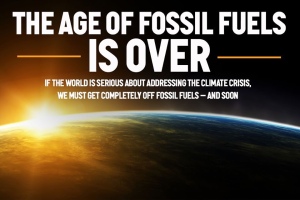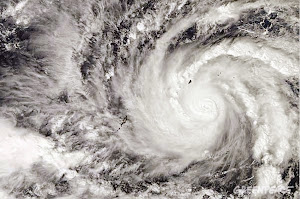We can have our beachfront properties — our Miami high-rises, our Hamptons mansions, our Jersey boardwalks — or we can have our beaches. But as geologist and Duke University emeritus professor Orrin Pilkey has been arguing for decades now, we can’t have both.
As the oceans warm and sea levels rise, coastal living is becoming an increasingly risky proposition. Any climate scientist would tell you not to invest in a beach house, and yet large-scale migration inland is something we’ve yet to see. The beaches themselves can withstand extreme weather, of course. But it’s our attempts to hold them in place, through techno-fixes like seawalls and beach replenishment, that ironically enough will end up destroying them. Sooner or later, Pilkey argues, we’re going to be forced to retreat. The question is whether there’ll be any beach left by then.
“The Last Beach,” which Pilkey co-wrote with J. Andrew G. Cooper, a professor of coastal studies at the University of Ulster, is but his latest attempt to drive home just how wrong-headed our push to build on and preserve shorelines is. It’s been an uphill battle; for Pilkey, what counts as progress was that people acknowledged his plea not to rebuild after Superstorm Sandy instead of just attacking him for suggesting it — even if they didn’t really end up following his advice.
Bring pollution, oil spills and the destructive business of sand mining into the picture, and it’s not so extreme, Pilkey told Salon, to imagine a future where beaches as we know them — as places to live and even as places to visit — will no longer exist.
Our conversation, which has been lightly edited for length and clarity, follows.
We don’t typically think of beaches as something that can “go extinct,” but it seems like that’s basically what you’re arguing here.
That’s exactly what we argue: that beaches in developed areas will not be there, that they will be replaced by seawalls large and small. There will be beaches left in remote places and on national seashores and things like that, perhaps — although they’ll be suffering too, because they’ll be eroding and retreating back separately from the developed areas, which will be standing still for a while.
By the time we really begin to see what’s happening, like we are right now in Florida, we’ll be worrying about Manhattan and Queens and Boston and Washington, D.C., Philadelphia, Miami, Charleston, all those cities. We fully expect that the great expense required to hold back the shoreline — which is a losing proposition in any event — will be overwhelming for them.
It seems to us to be pretty obvious — and I think most geologists would agree with this — that in a 50- to 100-year timeframe we’re in trouble. The best example of that, the proof in the pudding, is Florida, where they have hundreds of miles of highrise-lined shoreline. What can they do? You could move the buildings back, but that’s very costly and there’s no place to move them to. So what we see right now, especially with the current governor of Florida, is the building of seawalls right and left. All you have to do is declare an emergency and you can build a seawall.
In the book, you also discuss how beaches have become dangerous places. So would you say there’s also a loss of beaches, not physically, but as we are able to enjoy them?
Yeah, that was the point of that. We, by the way, were really shocked — the one chapter that was really out of our range was pollution, and we were rather shocked at the numbers. We saw repeated statements about how to use a beach, if you’re going to go to a beach what should you do and how should you use it, in the technical literature, but it hasn’t been getting out to the public. Maybe that’s a little bit of irresponsibility on the part of some of the biochemists in not getting that out to the public. On the other hand, I know what would happen. They would get heavily criticized, probably, as being alarmists.
But yes, the fact is that the beaches are getting more and more polluted, and as more and more villages and towns and cities crowd up against the beaches that’s going to continue. Some of the things the literature said seemed rather outrageous to us. One is never to go barefoot on a beach. That’s a tough one. The one thing that everyone agrees is a bad thing to do is to get buried in the sand. And who in this world has not been buried in the sand at some time in their life? If you have a cut or an abrasion of some kind… I’ve always thought that going in the salt water had a healing effect on cuts, but that was really wrong. I’ve told that to a thousand students over the years, and if any of them are reading this I take it all back. It’s very dangerous.
Well, not very dangerous. There’s a very low probability of getting something, but if you do, the probability of getting something serious is high.
And that’s worse than it used to be?
There are no numbers to show it, that we know of, but yes. The pollutants on beaches are higher than they used to be, we think.
I imagine that you must have trouble getting people to take some of the issues you write about seriously. For example, there’s the beach that was stolen in Jamaica — something like that can come off as an offbeat, funny news story instead of a serious environmental crime. Do you come across that sort of response often?
Where we are not taken seriously? Of course, but I’m used to that because I’ve been arguing for years that we need to move houses back and retreat from the shoreline, or let houses fall in, but not leave them in place. My argument in the past in similar situations has been that we have a choice at the shoreline: We can have beaches or we can have buildings, but we can’t have them both. You have to take your choice — and of course, that is met with a lot of derision by beach property owners.
“The Last Beach,” I anticipate, will be met with some derision, because it seems a little extreme. But it’s not extreme at all. Of that I am certain. In my 40 years of working on this I can see the situation deteriorating. We’re going down a bad road, no question about it, and I feel confident about that.
Right after Superstorm Sandy, you wrote an article for the New York Times arguing that we shouldn’t rebuild. What kind of response did that get?
I got some money — somebody wanted to support my next book. Everything that happened to me directly was good, and I think the response was really good, surprisingly good. I heard that the American Shore & Beach Preservation Association (ASBPA) — which is a civilian group beating a hard drum of “there’s no need to retreat” — in their newsletter they made a few nasty comments about me…
A long time ago, when I started saying these things, the response was really negative, like “aw, c’mon, don’t be stupid, nobody’s going to move back.” Now, moving back is not outrageous, and the relationship between seawalls and the loss of beaches is pretty widely known. I think I can say that the response to that editorial was so different than it would have been 30 years ago, 20 years ago. And that’s a good thing.
What about the actual response from people working on recovery from the storm? Did anyone listen? Is the East Coast going to be just as vulnerable the next time a storm comes?
Thirty years ago, the response would have been massive seawalls, there’s no question of that. Hurricane Sandy was the first time I’ve heard serious discussion on the part of the governors of New Jersey and New York about maybe moving back and not rebuilding. As it was, they didn’t do much — they basically rebuilt — but that was music to my ears. I’ve never heard that before. In the past it’s always been “c’mon, we’re Americans, we’re not going to throw up our hands and slink away.”
Almost every house, if there was a house left, had an American flag in front of it. It brought out patriotism, for some reason or another. I guess that’s better than depression, but it’s different. Even though most of these things didn’t bear fruit, we’re getting there. I guess I’m learning that it takes years to get this into the public understanding. I don’t know how many years it’s going to take before we really start moving back, but we’re going to have to, no question about it, or we’ll just give up on the beach. I really believe that we will give up on the beach, for the most part. Beach replenishment, you see, will not be feasible as the sea level rises, because you’re holding the shoreline back in place, where it doesn’t want to be.
The beaches will disappear much faster than they are now. In North Carolina a typical beach lasts about three years. In New Jersey it’s probably about the same, and in Florida, where the wave energy is a little lower, it’s about seven to nine years. In any case, it’s a very costly proposition and it’s definitely going to get more costly.
How far back do people realistically need to move?
It all depends on where you are. If you’re on a barrier island you can move to the back side of the island, but the problem with that is that the back side of the island is lower in elevation. The highest elevation on most barrier islands is at the front of the island, so you’re moving back but on the other hand the chance of being struck directly by waves is increased.
For the most part, if someone is going to go through the cost of moving they ought to get off the island. In Florida, there ain’t no place to get off the island. It’s very, very low and flooding quickly as the sea level rises. We have a photograph in the book of the so-called “Outlaw House” in North Carolina (Outlaw was the family name). It was moved back three or five times, depending on who you believe, and right now it’s very close to the beach once again. That’s a mom-and-pop cottage, and initially it was moved by mules. All the houses near the Outlaw House now are all McMansions. They can be moved, but they’re expensive. The McMansion that was in the movie “Nights in Rodanthe” was just moved down the highway a bit to a safer place — I say safer, but not safe.
In a recent interview, you said you’ve stopped defining yourself as a scientist and have instead become a scientific advocate. When and how did that change come about?
I started out as a deep-sea sedimentologist. I worked on the continental margin of North Carolina and the abyssal plains — I sampled 13 abyssal plains around the world — but I got tired of going to sea. When my parents’ house was damaged in Hurricane Camille, my father and I wrote this little book called “How to Live On an Island,” and it was three eighths of an inch thick and it cost a dollar fifty, and I couldn’t believe the impact it had. People were asking to quote us and so forth, and I realized there was a real vacuum here and I began to move to the beach. I traded a research vessel for a 16-foot skiff, and I’m very happy about that. It’s been very satisfying.
When I first came to Duke it was not possible, before you get tenured, to get involved with controversial things with the general public. One had to wait until one had tenure before one could start pounding on the table about these things, and by the time I got my 16-foot skiff I was already tenured. I had also been a journal editor and a couple other things, and that gave me credibility in the scientific community. Nonetheless, I remember a number of times being criticized by scientists, basically saying “you’re off-base for doing this kind of thing.” I have a 25-book series, “Living with the Shore” for every state, and we have local geologists who were the senior authors of each of these books. I think for probably every book, at least one of the authors would say “I’m not going to lower myself and make science so simple,” or something to that effect, saying that “we can’t expect the public to understand everything we’re doing.”
But I don’t think I hear much of that anymore. I think at least geologists, and probably a lot of others now, are recognizing the value of being able to converse with the public. I know that most universities, Duke included, appreciate work that has an impact on the general public. It’s not like it was when I started at all. We are rewarded for doing such work, although there are local problems in individual states, probably in every state, where public schools still have problems. Here in North Carolina, I know at least two, maybe three geologists who have been asked to turn in their emails, or to furnish all emails that have to do with sea-level rise.
What you’re asking of the public is really difficult: You’re asking them to give up something they love, that they can protect in the short term, in favor of looking at the big picture. It’s something that people come up against with a lot of these environmental and climate problems. Do you have any insights into how to get that message through to people?
The reason you go to beaches is because you went down there with your mother and father during the summer and had the most wonderful time in your whole life, and what could be better than to live there year-round? But here in North Carolina we have some really good newspapers, at least on this issue. I spent a few years back in Woods Hole, Massachusetts, and I found that the people there were far less educated on the problem of beaches and seawalls and retreating shorelines. It was a very marginal thing in Massachusetts, but in North Carolina we have a much longer shoreline and a much higher-energy shoreline. So it’s not a surprise to most people. If they come here from Kansas it might be a surprise, but the locals here are pretty well-educated. Excepting the particular political situation we have right now, which is very pro-development — but that comes and goes — I think in North Carolina we’re better prepared than some other states.
The real resistance to good coastal management with a long-term view is coming not from the people who came down there because their mommy and daddy brought them to the beach. It’s coming from the people who are making money on it. From what I’ve seen here, the high-cost developments are the ones who are trying to change the laws to let them build seawalls. They’re going to protect the houses; they couldn’t give a damn about the general public. Up on South Hampton, New York, rich people are building massive walls. They’re doing things that are illegal in some communities, but when you have billions of dollars you can get an army of lawyers to hold off the community very readily. Wealthy communities are the problem. More













